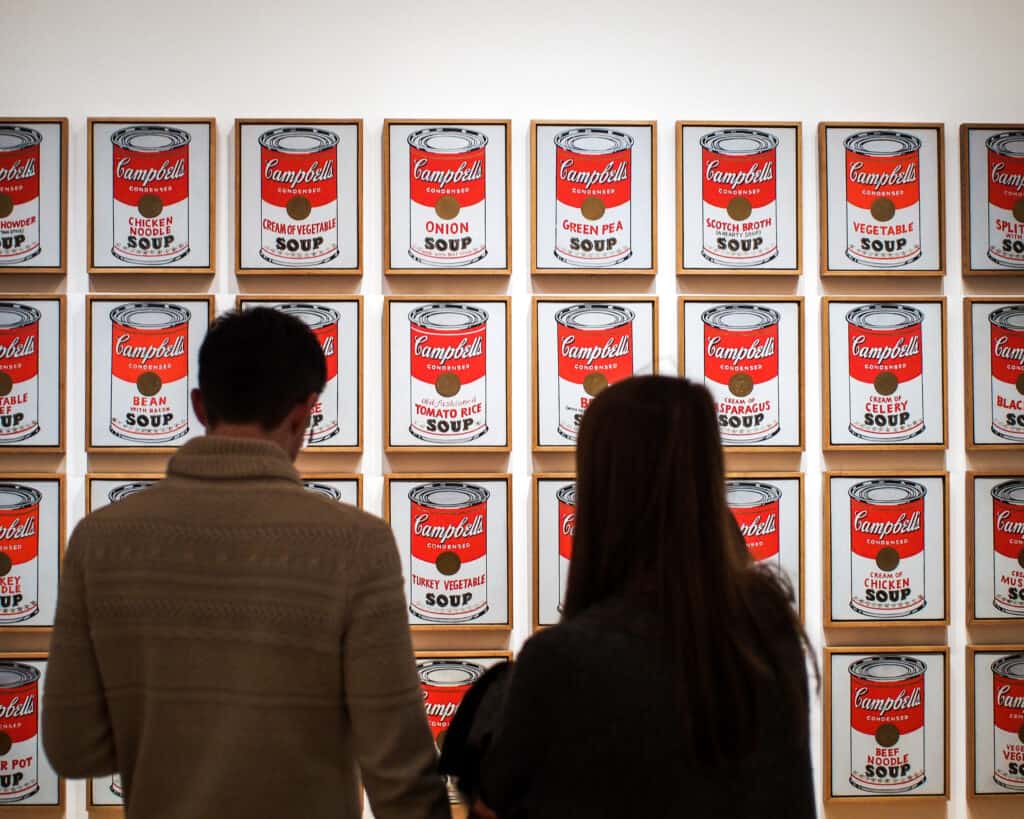As a form of expression, as cannot be streamlined to what a few artists or society believes. Andy Warhol decided not to follow the likes of Da Vinci and forged his own path – pop art. Warhol’s most popular and iconic painting was of the Campbell’s soup cans as the subject. But why did he explore his artistic nature to paint a soup can?
Andy Warhol painted Campbell’s soup cans because he enjoyed eating the soup from the brand.

The reason behind the art is not deep, but the creative process is intricate. Here’s all we know about the soup cans painting and Andy’s creation process.
What influenced Andy Warhol to paint soup cans?
According to Andy Warhol, he ate the same lunch for 20 years – Campbell’s soup cans were his go-to lunch for two decades. Before making the paintings, Andy had worked with high-end brands like Tiffany and Co., Dior, etc.
But the commercial artist wanted more out of his art. He wanted to be recognized and not keep hiding under the shadows of brands that contracted him. Andy wanted museums to hold his work and critics to share their opinions.
So, with this motivation, he whipped out his brush and ink, then created a masterpiece that the world will never forget. His story tells people that when you get tired of hiding in the shadows and start taking actionable steps, then there’s nothing that can stop you.
How did Andy Warhol paint the soup cans?
The major drawing form in Andy Campbell’s soup painting was tracing.
Andy Warhol would project the image of a soup can on a black canvas, then he would trace along the lines with a brush and paint. His aim was to make the art pieces appear mechanical, but there are no perfect pieces, meaning that he made some errors on the paintings.
So as much as Andy tried to make the paintings look mechanical, the red spots on the paintings and unevenly stamped fleur-de-lys show that he painted the cans with his hands.
Warhol showed a key contradiction in Pop Art by using fine art techniques to draw an everyday manufactured object. Even though they were meant to look like they were made by a machine, each painting was a little bit different, and not just in the flavor written on the label.
The paintings were received with heavy criticism. People know how to react to a piece that seemed different from what they knew. One critic even said that the artist was either a soft-headed fool or a hard-headed charlatan.
But the art turned out to be one of the most important pieces of art in the 20th century.
When did Andy Warhol paint Cambell’s soup cans?
Andy Warhol first debuted the Campbell’s soup cans paintings in 1962 at the Ferus gallery. One of the owners of the gallery felt like the painting looked weird so he kept them on a narrow shelf during the opening.
What art movement was Andy Warhol part of?
The name Andy Warhol is almost synonymous with the pop art movement.
When it came to art, pop was a radical upheaval. The “pop” in Pop art refers to images taken from advertising, comic books, and other forms of popular culture, rather than traditional art subjects such as landscapes, battle scenes, or portraits.
To criticize the effect of mass production and consumerism in American culture, they employed irony and wit. In the 1950s, abstract artists like Jackson Pollock may have praised themselves as creative, individualist geniuses, but pop artists did the opposite. They tried to hide or get rid of things like brush strokes that showed how they made their art.
This made their work look almost mechanical, like the mass-produced items it showed.
Did Andy Warhol create the Campbell’s soup can label?
The Campbell’s soup was already a successful brand before Andy Warhol painted it. If they weren’t as famous, Andy may not have recognized them and used them as a subject.
How much did Andy Warhol sell the soup can paintings?
Andy Warhol sold each Campbell’s soup cans painting for $100 and got $50 as commission.
How much was the Cambell’s soup cans painting auctioned?
Andy Warhol died in 1987, but 19 years later in 2006, the artist’s soup cans painting was auctioned for $11.8 million and was one of the most expensive pop arts in history.
The painting consists of 32 cans of different flavors.
Other consumer brands that Warhol used as subjects in his art include Brillo Pads and Heinz Ketchup. He used images of famous celebrities as subjects as well, including Elizabeth Taylor, Muhammad Ali, and Marilyn Monroe.